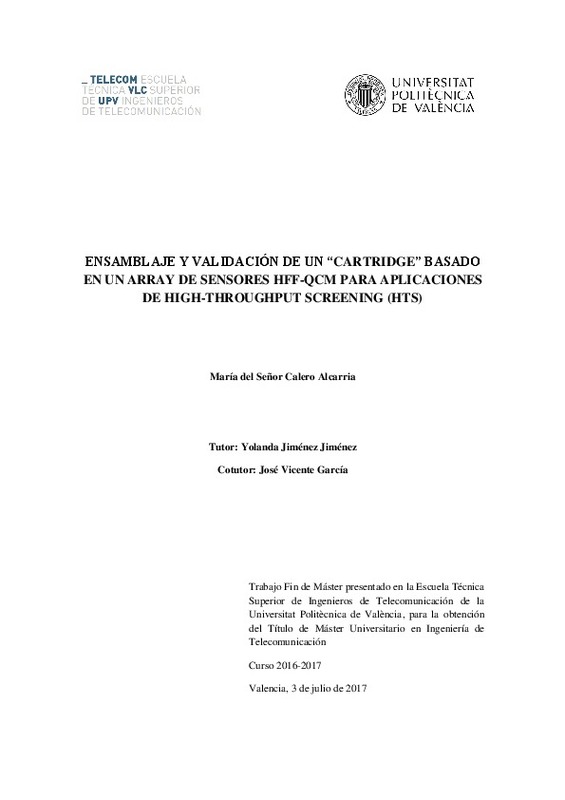|
Resumen:
|
One of the outstanding challenges in the areas of health and food safety and quality is the development of new High-Throughput Screenig (HTS) techniques that allow the simultaneous monitoring of multiple samples. A key ...[+]
One of the outstanding challenges in the areas of health and food safety and quality is the development of new High-Throughput Screenig (HTS) techniques that allow the simultaneous monitoring of multiple samples. A key element in this type of system is the cartridge. This element, which contains the multiple samples to analyze, is connected to the analysis system to perform the analytical determination. The cartridge to be assembled and evaluated in this TFM will be formed by three elements: 1) an array of HFFQCM sensors properly functionalized for a key application, 2) a layer of plastic material which traces the microfluidic channels on the different sensors and 3) A printed circuit board (PCB) through which the array of sensors will be connected to the analysis system. Different designs of the array will be proposed. The task of the student will consist in studying and evaluating their pros and cons in order to select the more suitable array design according to the criteria of size, cost and interference between sensors. The array must be attached to the PCB on one side, for this purpose a positioning and dispensing equipment, which will be programmed by the student, will be used. On the other side of the array, a plastic material that will define the microfluidic channels will be fixed by means of the positioning and dispensing equipment. Finally, the response of the complete cartridge will be evaluated, for that, the electrical admittance of each sensor and the effect of the fluidic on the final response will be studied
[-]
Uno de los retos pendientes dentro de los ámbitos de la salud y la seguridad y calidad alimentaria es el desarrollo de nuevas técnicas de High-Throughput Screenig (HTS) que permitan la monitoriazión de múltiples muestras ...[+]
Uno de los retos pendientes dentro de los ámbitos de la salud y la seguridad y calidad alimentaria es el desarrollo de nuevas técnicas de High-Throughput Screenig (HTS) que permitan la monitoriazión de múltiples muestras de forma simultánea. Un elemento clave en este tipo de sistemas es lo que se conoce como el cartridge (cartucho), se trata de un elemento que contiene las múltiples muestras a analizar y que debe ser conectado al sistema de análisis para realizar la determinación analítica. El cartrigde que se ensamblará y evaluará en este TFM estará formado por tres elementos: 1) un array de sensores HFFQCM debidamente funcionalizados en función de la aplicación, 2) una capa de material plástico que trazará los canales de microfluídica sobre los diferentes sensores y 3) una placa de circuito impreso (PCB) en la que irá conectado el array de sensores al sistema de análisis. Desde la dirección del trabajo se propondrán diversos diseños del array que el estudiante tendrá que estudiar y evaluar sus pros y contras, el primer resultado del trabajo será la selección del diseño de array más adecuados atendiendo a los criterios de tamaño, coste e interferencia entre sensores. El array deberá ir fijado a la PCB por una cara, para ello se utilizará un equipo de posicionamiento y dispensación de los epoxys necesarios para realizar la fijación, el estudiante deberá programar dicho equipo. Una vez fijado el array a la PCB, por la otra cara se fijará el material plástico que definirá los canales de microfluídica, el cuál deberá ser diseñado en función del array elegido. Para su fijación también se utilizará el equipo de posicionamiento y dispensación. Por último se evaluará la respuesta del cartucho completo, se estudiará la admitancia eléctrica de cada sensor y el efecto de la fluídica sobre la respuesta final.
[-]
|







